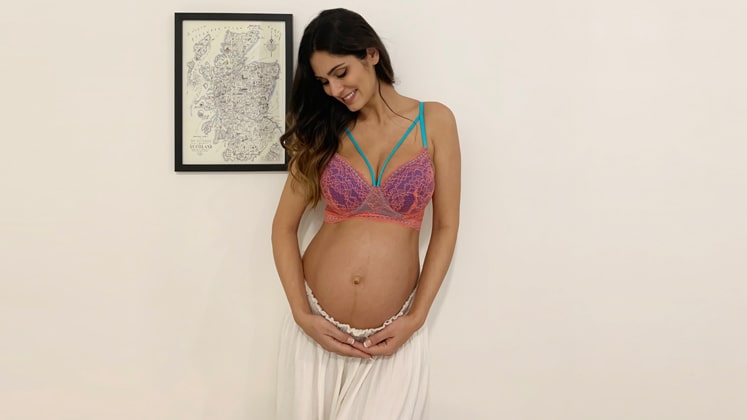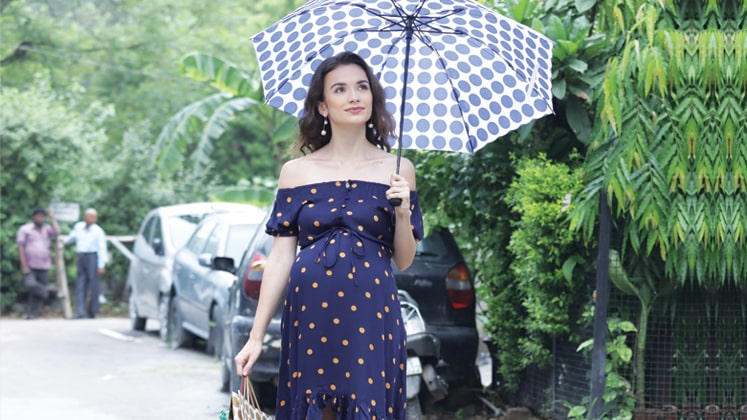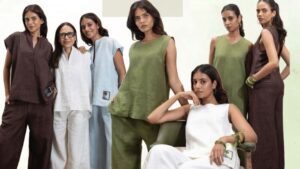India has evolved tremendously in the recent years and so have the fashion trends in the country in different segments and this evolution process has ultimately led to emergence of few new categories. One amongst them is the maternitywear segment which has very recently taken shape as a standalone category. What was once an assortment of oversized clothing or men’s clothing to hide the baby bump, is now an expansive offering of stylish, trendy as well as functional maternitywear clothes that pregnant women are adopting in fashion, showing off their protruding belly. “The maternitywear market has become the new ‘it’ in the Indian apparel industry. Today’s working women no more prefer shabby nighties; they’re picky about the fabric, flow and design of the garments they wear. These days, many online and offline maternity brands offer a wide range of options for moms-to-be. Fast fashion and ready-to-wear brands are also looking at shelving fashion for these new mums. And the range they offer is mind-boggling – denims, trousers, shirts, skirts, maxis, kurtas and much more,” asserts Nidhi Yadav, Creative Head and Founder, AKS Clothing. While the category has a commendable demand in developed regions such as North America and Europe, India gradually is entering into the category and is moving upwards at a rate of around 15-17 per cent on year-on-year basis. A number of factors have facilitated the evolution and growth of this category in India including, the rise in number of expecting mothers in the workforce and high disposable income as well as the liberalisation of the market which has opened up to the increasing demand for these stylish maternitywear across the country. According to statista.com, the global maternitywear market was valued at approximately US $ 6.1 billion in 2016 and is expected to cross US $ 7 billion by 2023, growing at a CAGR of more than 2 per cent during the forecast period 2016-2023.
Maternitywear was non-existent until a couple of years back and it got recognition very recently and with time, a solution-based category has become a necessity for the new mothers. This growing necessity or demand of the segment has led to a number of brands venturing into this like H&M, Zara and lingerie brand Zivame. They have either entered with a sub-brand or a separate collection for pregnant or nursing women. India is accepting the trend, and according to a report, the maternitywear industry in the country, which was estimated at Rs.2,000 crore in 2017, is growing at around 15-17 per cent year-on-year, thereby holding enormous potential for this burgeoning fashion retail vertical.
A push in the right direction

The new moms-to-be or new moms are not shying away from the attention that a baby bump attracts nor are they choosing to stay at home during the pregnancy tenure. They’re on the move – going out, visiting relatives and even attending their offices and they wish to keep their fashion game up-to-date throughout this period. Rakhi Khera, Managing Director, Abiti Bella, says, “Women are much more educated about niche fashion because of the digital transformation, increased media awareness and social media. They have become conscious of their special needs during pregnancy and are willing to spend on obtaining apparels to suit these necessities. On an average, a woman might be carrying at least 8-10 different ensembles to wear during her pregnancy. The major factors facilitating this trend are: awareness and style consciousness, financial independence, emergent women workforce and affordability, among other things.” Also, smaller family sizes have made each pregnancy special for today’s mothers and they would like to live to the hilt during this time. Other factors like as Nidhi states ‘influences from the big screen and social media’ too have added to the growth of this segment. The celebrity women are now flaunting their bumps in the best fashion available to them. Diana Hayden got clicked at a beach and the latest Bollywood mums – from Kareena Kapoor to Neha Dhupia, Kalki Koechlin to Rani Mukherji – have all been clicked looking fabulous in skirts, fusionwear, maxi dresses and untucked shirts with absolute elan.”
Meanwhile, new generation working mothers of today are worried about trying to look presentable and trendy not just during pregnancy but while managing their breastfeeding schedule as well. The post-partum body requires quite a lot of attention and needs a comfortable innerwear which suits the changing demands of the body and helps nursing mothers the most. A large number of mothers are still unaware about the benefits of correct nursingwear. A mother’s body undergoes a host of changes after pregnancy and buying the right clothes is just one step in the right direction. Special bras like nursing, sleep bras, etc., have taken the segment by storm. “The evolving trends and usage have opened a whole new segment in the market, and over the recent years, the maternitywear market has witnessed a considerable growth in the categories of maternity bras, nightwear and fashion clothing. However, we are yet to see a sizeable consumption in this category. With gradual awareness building up and with e-commerce, the penetration of the products has got into the lengths and breadths of the country. We are hopeful that very soon, this will be one of the fast selling categories,” says Suman Chowdhury, Chief Operating Officer, Clovia.
What delivers?
Quite literally a growth market, maternitywear has been witnessing an influx of high street maternity styles, which is ultimately putting pressure on the specialist retailers and brands to up their game and make the consumers aware about the value of investing in a rather expensive, technical maternity and nursing clothing category. “The needs after the baby is born are completely different from those during pregnancy. I think post-maternitywear has to be completely nursing-friendly, while the ones earlier can camouflage in the XXL or XXXL kind of apparel. Working nursing mothers are the growth drivers in comparison to pregnant women. Besides, overall per capita spend on mom and child care has grown primarily due to emerging categories in the market and price has not deterred the movement. On an average, the mass market, which is 52-53 per cent of India’s population is spending 1-1.5 lakh in 4 years of parenting and childcare when they’re raising a kid and living through the pregnancy journey. These are just ballpark figures which have led the mom and childcare market to be as large as a US $ 74 billion in India today between products and services put together. This is growing at about 30-35 per cent on year-on-year basis,” informs Anvita Dekhane, Chief of Staff, BabyChakra.
In terms of product assortment, prenatalwear includes clothing, gowns, support bras and briefs. Post-natalwear includes nursing bras, sleep bras, nursing aprons, nursing tops, nursing pads, bra tank tops, vests, maternity briefs, gowns and nighties, which have zippers and double panels on both sides to nurse. Other nursing accessories include breast pumps, gel pads, breast pumps, nursing bibs, shapewear, lotions, nipple protectors and feeding pillows. “Out of all the product assortment priced between Rs.699-Rs.2,499, dresses and tops are functionally the most appropriate nursingwear for our aware and conscious set of consumers. We have consciously kept our range affordable to take care of the fact that most of the attires may not be used post pregnancy except for nursingwear. Almost 35 per cent of overall revenue is achieved from the maternitywear range. The fastest moving sub-category at Abiti Bella is dresses; maxi dresses are hot favourites in maternitywear as they smoothly accommodate the mothers throughout their pregnancy and Indian women prefer garments which help them cover appropriately. Layered ensembles are preferred over others, and in terms of prints, florals are more in demand and bright colours are in trend while laces are chosen for baby showers,” avers Rakhi. While the category contributes to a little less than 3 per cent to Clovia’s revenue, it is the fast-evolving category for the brand and is growing at a pace of over 200 per cent Y-o-Y. “The fastest moving trend in this category is cotton nighty with zip closures for convenient feeding access. This style is crafted from 100 per cent cotton fabric which works best for the Indian climates. We are investing on building this category further with newly launched on the basis of the phenomenal response to our initial offering,” adds Suman. While the average ticket size for Abiti Bella is Rs.2,500-Rs.3,000 , comprising of 2-3 garments, it’s around Rs.500 for Clovia and approximately Rs.1,000 for AKS Clothing.
Today’s women, in order to always be on the move even during pregnancy, are buying the latest fashions in comfortable cottons, linens and latex-enmeshed fittings (relaxed elastics around the belly for trousers, pants and denims) and these trends are translating into a lot of binge purchases for the new moms, thereby fuelling the emergence of a slew of brands in the segment.
The back-end intricacies
As the demand and market size of maternitywear is growing at a consistent rate, a number of manufacturing companies in India have also understood the potential of the market and are entering into this category in order to grab a share of the burgeoning need and demand. However, manufacturing of a maternity wear garment is not the same as other merchandise and the manufacturing firms put in a lot of innovation and research-driven insights to come up with a collection that’s fit for the pregnant or nursing moms. They identify and get versed with the ill effects of wrong size bra, fabric construction and impact on breast feeding patterns, and aim to remove these anomalies through new fabric development and enhancement in construction technology as well as the appeal of garment. According to Nidhi, “For maternitywear, despite the weather condition, the preference is natural, breathable fabrics or soft woolens. In line with this, we prefer to work with cottons, linens, bon-bon, bengaline, lycra and stretch denims for our merchandise. In fact, the cotton lycra mix is a definite go-to, especially for over-the-bump trousers or denims. The process of manufacturing of maternitywear products is very different from other garments because they need extra attention. We need our garments in this category to be flowing, yet fit. They should have room to accommodate a growing body and yet not look drab or baggy. Furthermore, details like tassels, chains and metallic fixtures require a thought too as they can cause discomfort. So, the difference lies in the fit specifications, materials used and the care with which each item is created, checked and rechecked before leaving the warehouse.” As for Clovia, the brand uses skin-friendly, moisture-absorbent fabrics, primarily cotton blends for its maternitywear range, which are manufactured in ‘state of the art facilities with vertically integrated set-up, where every step, from yarn to garment, is closely monitored and quality checks and lab tests are done’ to ensure a safe product.
Besides using best of fabrics and technology, manufacturers are also going for innovation to offer the best they can to the expecting or newbie mothers. Nesa Maternity Wear (based out of Mumbai) is one such manufacturing firm which is using innovation for safeguarding the mothers and their babies from harmful UV radiation. “We are testing a range of products in this category. This is in a very initial stage and the products are priced between Rs. 900-Rs.1,200 but once they hit the market, we will manufacture in bulk and would lower the prices to make it more affordable. The radiation affects you when you have more liquid content in your body. Normally, our body consists of 70-80 per cent water but when a woman is pregnant, the water content in her womb increases and so, the radiation is targeted on that area. Our endeavour is to create a safe environment for the foetus and the mother. The technology we use in these garments convert the radiation energy into other forms of energy, thereby considerably lessening the effects of it,” asserts Vikas Singh, Chief RF Engineer, Nesa Maternity Wear.
Challenges and the way forward
Globally, North America dominates the maternity apparel market with a market share of 33.11 per cent in 2016 followed by Europe. The demand is definitely higher in the developed regions but the sudden surge in the revenue graph has shown that the maternitywear industry in India is eventually transforming from a small-time interest market into a growing commercial industry and is moving from unorganised to an organised one. While the market is looking quite lucrative holding enormous potential of providing more and better options of apparel for pregnant women and new moms, it has its fair share of challenges. Nidhi elaborates, “There are a lot of challenges or hurdles in this segment. There are no standards for apparel sizes in India or the world over, since there is unpredictable growth in a woman’s body during pregnancy which is unique to each woman. Also, availability of quality fabric for this range as also the availability of special factories and workforce for this category are a challenge. In addition to this, the online channels in the segment do not adhere to much details because of lower revenue contributions in comparison to the other larger categories, further depreciating this evolving segment.” Even as this and many other challenges like maintaining the affordability while offering quality products, have clouded the segment here and there, the future for maternitywear market still looks bright. As Rakhi puts it, “Even though the consumers feel that these clothes are for a small period of time, there is an emotional value connected with them which is immense.” The industry players opine that the demand is going to only increase and would never die and the growing population of working mothers is going to be the key driver of the segment.
Besides, the category which is still evolving and is fairly new, is also on its way to enter Tier-2, Tier-3 and beyond regions of the country. The ease of delivery from online channels is really helping the brands in the category (which are mostly online firms) gain a lot of ground. Anvita asserts, “We do see that there is a lot of latent demand for this category, and realising this, we are launching different languages and bringing in new products that are a lot more friendly to the target consumers in Tier-3 and Tier-4 towns as well, but at the same time, we do realise that the paying capacity is considerably less in these areas and it would take time to become a hit in the hinterlands of the country.”









